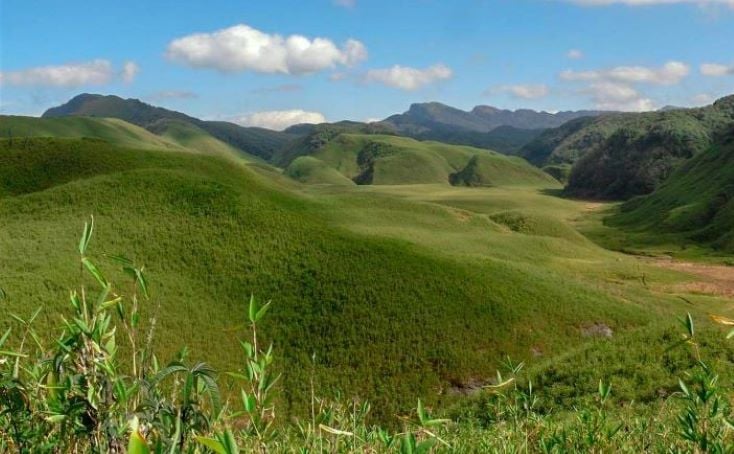 INTERNATIONAL DESK: Residents living in Manipur’s Reserved Forest (RF) and Protected Forest (PF) areas have been served eviction and show-cause notices since 2016. The Kuki tribes who had settled in K. Songjang village in Churachandpur were evicted from their villages.
INTERNATIONAL DESK: Residents living in Manipur’s Reserved Forest (RF) and Protected Forest (PF) areas have been served eviction and show-cause notices since 2016. The Kuki tribes who had settled in K. Songjang village in Churachandpur were evicted from their villages.
The government argued that several such households had been illegally encroaching on the RF and PF areas, and that the state must initiate this legal eviction procedure to safeguard the forest amid climate change and water scarcity issues in Manipur. Since 2016, several households have been evicted from RF areas.
About 84 households were evicted from Heigang RF in 2016; 74 were evicted from Awangching RF in 2018; 16 were evicted from Langol RF in 2019; and about 83 households from Waithou RF, according to RK Amarjti Singh, Conservator, Central Forest Circle, Manipur.
Singh claims that Manipur only has 4.4 per cent RF, 14.4 per cent PF, and 54.81 per cent Unclassified Forest, most of which is concentrated in the State’s hilly regions. This eviction drive is only taking place in the RF and PF areas. He stated that the eviction drive excludes the Unclassified Forest area. About 984 sq km of RF, 3254 sq km of PF and 13180 sq km of unclassified forest are found in Manipur.
The total Recorded Forest Area (RFA) is 17418, or 78.01 per cent, of the State’s overall 22327 sq km of land (Forest Survey of India, 2021).
Singh urges the public to conserve RF and PF because their percentages are lower than those of Unclassified Forest, which keeps the ecological health of Manipur in balance (Amarjit, 2023). There are currently about 39 reserved forests in Manipur, including wildlife sanctuaries and national parks.
Response to eviction notice
On 20 February 2023, the residents of K. Songjang village were served with an eviction notice for the construction of a house along the Churachandpur-Khoupum PF stretch in Churachandpur. Most households, about 14 homes, were mapped out to have been built after 2021. So, these households were deemed illegal and allegedly received eviction notices.
Subsequently, the village chief was given notice of the legal process before they were bulldozed to destruction. Another show-cause notice was issued for Kungpinaosen, Kangvai Sub-Division, Churachandpur District, Manipur.
The villagers were notified to leave for the same reason as K. Songpijang. However, the Kuki People’s Alliance claimed in a statement released on 7 March 2023 that Kungpinaosen village, including its offshoot five villages, namely K. Songjang, K. Hengmol, K. Lhangnom, New Kungpi Part-1, and New Kungpi Part-2 villages, are not included in the area that has been demarcated as Churachandpur-Khoupum PF since the FSO proclamation dated October 29, 1971.
The organisation also claimed that the villagers had every right to reside in K. Sojang village because it had been there since before the Indian Forest Act of 1927 was put into effect.
Considering this issue, the All Tribal Student Union of Manipur (ATSUM) released a statement on 21 February 2023, describing the hillside eviction drive cruel and inhuman as it curtailed the means of subsistence for the people who depended on the forest. They also assert that the government violated the correct procedures when declaring certain forest areas as reserved, particularly in the Hill Areas, as a procedural error. In resolution No. 38/2020, passed on 11.0.2021, the Manipur Legislative Assembly (MLA) Hill Area Committee (HAC) noticed that the declaration of RF after 1972 was invalid. It maintained that any declaration of RF, PF, or wildlife sanctuaries/national parks made on or after 20 June 1972 must first receive approval from the HAC regarding Scheduled Matters of Article 371-C of the presidential order of 1972.
Emerging debates
Recent eviction orders and the resistance by the affected people, and protests by the Chin-Kuki civil society organisations have sparked a number of new discussions.
Currently, the discussion is centred on topics like immigration, forest conservation, increasing villages in the hills, and abnormal population growth in the Hill Areas.
The larger discussion is concentrated on climate change and has decriminalised the Hill Tribes of Manipur for engaging in activities like illegal poppy and timber trades, among other things, in many news channel discussions like Impact Tv Manipur and others state newspapers.
According to the general view of the populace, these actions have ultimately contributed to water scarcity and deforestation in the Manipur hills and valley.
As a result, there is a demand for the state government to take over the management of the forest resources, particularly in the hill areas, and impose strict laws, rules and regulations. In this scenario, what is affecting Manipur’s climate change is still questionable. Is it only the deforestation in Manipur’s hilly areas damaging the ecosystem? What about development infrastructure projects which lack social and environmental impact assessments? What about environmental pollution brought on by anthropogenic human activity in Manipur? It is essential to talk about the crucial aspects of Manipur’s changing climate alongside external forces contributing to deforestation in the hilly areas.
Larger discourse on climate change
Colonialism and capitalism have historically facilitated industrialisation, militarisation, and the development of a carbon-intensive economy, all of which have contributed to anthropogenic climate change. The centuries-long colonial invasion “caused anthropogenic environmental changes that rapidly disrupted many Indigenous Peoples, including deforestation, pollution, modification of soil-use amplification and terraforming for specific types of farming, grazing, transportation, and residential, commercial, and government infrastructure” (Whyte, 2017). In other words, rather than being a recent phenomenon, vulnerability to climate change continues the colonisation process.
Guha and Gadgil (1989) argued similarly for the Indian context, claiming that the colonial foresters’ or departments’ strategy in India was to exploit the forest through timber extraction and generate income from it under the guise of forest conservation. Many Indians, particularly the tribal groups, have resisted colonial attempts to control their lands, forests, and water resources. The resistance movement in the post-colonial era still continues.
Neoliberalism’s emergence in Indian post-1991, particularly in Northeast India, gave focus to the country’s “Look East” policy. Since then, tribal communities in India have protested against the Indian government’s numerous laws that support the mining industry and capitalist forms of projects which seek to alienate tribal communities in the name of development and national interest.
For instance, the Oil Refinery movement in Assam (Baruah, 2011); the tribal movement against Uranium mining in Meghalaya; and the struggle against big dam construction in Arunachal Pradesh, Sikkim, and Manipur and so forth are some environmental and social movements undertaken by tribals in Northeast. Resources have been privatised, and wealth has been disproportionately amassed through profit and the appropriation of land and resources from people whose livelihoods depend on land and forests for industrialisation, eco-tourism, and the extraction of oil and minerals (Yumnam, 2021; Kikon, 2019). These activities and factors have sped up climate change in Northeast India, especially in Manipur.
Contributing factors to climate change
In the context of Manipur, the more considerable discussion on climate change and the factors influencing it needs deliberation. The general narrative about poppy cultivation causing deforestation should not invisibilise the larger discourse on climate change in Manipur. Indeed illegal poppy cultivation has its share of implications for the local ecosystem, and it needs to be stopped immediately.
The initiative on the ” War against drugs” and “Chief Minister’s Manipur Green Mission” campaign initiated by the Government of Manipur is both necessary and commendable. But Government of Manipur should also focus on the adverse effects of more significant development initiatives taking place in the State. The ineffective dams in Manipur are still unproductive but have harmed the environment to a great extent (Langhu, 2019; Yumnam, 2021). Various developmental projects under the Act East Policy (AEP) have been implemented. For instance, constructing trilateral international highways between the three nations, India, Myanmar, and Thailand, with Manipur as their gateway point and the Imphal-Jiribam railway project in India, are matters of more significant worry, environmentally speaking.
Moreover, numerous Memorandums of Understanding (MoUs) have been signed between the Manipur State and business corporations that support the extractive industries through the Public-Private Partnership (PPP) model under AEP. These projects will undoubtedly alter the local ecological system, which should be of more significant concern (Yumnam, 2021).
Once regarded as a frontier with rugged mountainous terrain, the NER is now seen as the gateway to Southeast Asian countries (Karlsson, 2011; Wouters, 2020); under pressure, progressive development projects are being pushed together with the implementation of AEP. Large forest tracts are being acquired and destroyed to build infrastructure, extract resources, construct the Imphal ring roads, and consider building concrete dams (Yumnam, 2021). More severe threats include rapid urbanisation, market demands for timber from plywood production companies, firewood from brick factories and military bases, etc., and charcoal from restaurants and hotels. Additionally, connectivity and the development of modern machinery like handsaws, sawmills, and trucks have significantly accelerated deforestation (Langhu, 2020). The more significant threat to nature comes from unrestrained, capitalist-driven exploitation of forest resources for profit, which needs particular focus.
The introduction of the Indian Forest Act in 1878 and 1927 converted all communal forests into state property and destroyed forest-covered areas. For instance, the colonial authorities cleared a substantial forest area for constructing the Imphal-Cachar and Imphal-Dimapur highways. The historical examination of the Colonial forest laws in India and Manipur has distinctly looked at the exploitation and destruction of forests to generate profit and privatised and commercialised forest resources. The colonial laws have legitimate capitalist forms of power to acquire the land and forest resources for extractive mining activities at present is a significant concern. For instance, the Land Acquisition Act of 1894 and 2013 has permitted the State to acquire land for any public purpose or a company under the Eminent domain doctrine.
Many MoU has been signed between the Government of Manipur and the corporates for extracting oil resources, palm oil and developmental projects that require significant consideration before commencing. The Government of Manipur should review the MoUs signed with the corporates or companies for extracting minerals resources, including Jubilant Energy’s Plan for oil exploration, limestone mining, and chromite mining in Ukhrul (Yumnam, 2021) etc., taking due cognisance of these issues and challenges.
The state should focus more on providing alternative means of subsistence to discourage the hill people from continuing poppy cultivation in the hills. The market needs constant monitoring to check illegal drug trafficking and manufacturing.
Education, employment opportunities, ensuring inclusive infrastructure development in the hills and valleys, and other livelihoods that sustain the ecosystems, among other things, are becoming more crucial when increasing the unemployment of educated youths in the State. Such government initiatives will only end the vicious cycle that the Hill Areas’ inhabitants are caught in and might reduce the poppy cultivation in the hills.
The world’s events and disasters have taught us that nature has its way of preserving its equilibrium. Such issues and problems are not always resolved by human beings blaming and providing illogical justifications. It is noteworthy that the Hills have long protected the State’s forested areas, maintaining the State’s ecological health.
The Hill people effectively manage shared resources like community land, water, and forests because of their deeply ingrained values and still-viable cultural practices. Because the assets are inherited from their ancestors, these communal resources such as land could only be transferred to close kin and relatives.
The forest is shielded from exploitation by capitalists who view the forested areas as a commodity and a way to amass wealth through these customs and traditional knowledge systems. The only way the tribal communities in Manipur can lessen the impact of climate change is by adhering to the cultural norms and practices of communal resource management, which Article 371-C of the Indian constitution also protects. (EM)
iNews covers the latest and most impactful stories across
entertainment,
business,
sports,
politics, and
technology,
from AI breakthroughs to major global developments. Stay updated with the trends shaping our world. For news tips, editorial feedback, or professional inquiries, please email us at
[email protected].
Get the latest news and Breaking News first by following us on
Google News,
Twitter,
Facebook,
Telegram
, and subscribe to our
YouTube channel.



